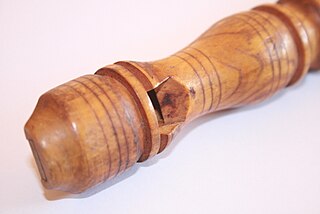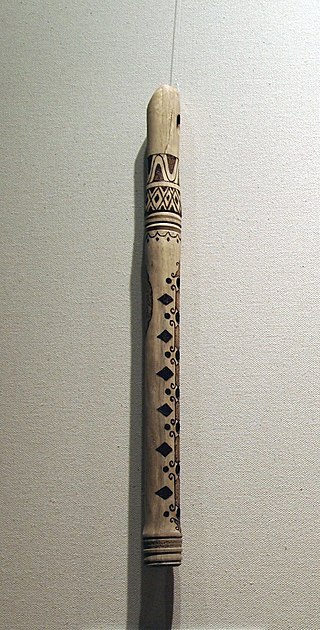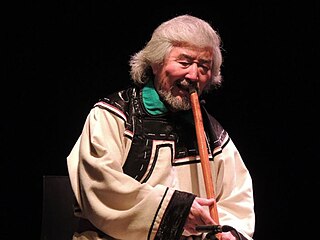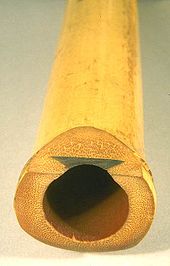
The flute is a member of a family of musical instruments in the woodwind group. Like all woodwinds, flutes are aerophones, producing sound with a vibrating column of air. Flutes produce sound when the player's air flows across an opening. In the Hornbostel–Sachs classification system, flutes are edge-blown aerophones. A musician who plays the flute is called a flautist or flutist.

The tin whistle, also known as the penny whistle, is a simple six-holed woodwind instrument. It is a type of fipple flute, putting it in the same class as the recorder, Native American flute, and other woodwind instruments that meet such criteria. A tin whistle player is called a whistler. The tin whistle is closely associated with Irish traditional music and Celtic music. Other names for the instrument are the flageolet, English flageolet, Scottish penny whistle, tin flageolet, or Irish whistle.

The ney, is an end-blown flute that figures prominently in traditional Persian, Turkish, Jewish, Arab, and Egyptian music. In some of these musical traditions, it is the only wind instrument used. The ney has been played for over 4,500 years, dating back to ancient Egypt, making it one of the oldest musical instruments still in use.

The term fipple specifies a variety of end-blown flute that includes the flageolet, recorder, and tin whistle. The Hornbostel–Sachs system for classifying musical instruments places this group under the heading "Flutes with duct or duct flutes." The label "fipple flute" is frequently applied to members of the subgroup but there is no general agreement about the structural detail of the sound-producing mechanism that constitutes the fipple, itself.

The kaval is a chromatic end-blown oblique flute traditionally played throughout the Balkans and Anatolia. The kaval is primarily associated with mountain shepherds.

Chinese flutes come in various types. They include

The quena is the traditional flute of the Andes. Traditionally made of cane or wood, it has 6 finger holes and one thumb hole, and is open on both ends or the bottom is half-closed (choked). To produce sound, the player closes the top end of the pipe with the flesh between the chin and lower lip, and blows a stream of air downward, along the axis of the pipe, over an elliptical notch cut into the end. It is normally in the key of G, with G4 being the lowest note. It produces a very "textured" and "dark" timbre because of the length-to-bore ratio of about 16 to 20, which is very unlike the tone of the Western concert flute with a length-to-bore ratio of about 38 to 20.
The various nations of the region include the Arabic-speaking countries of the Middle East, the Iranian traditions of Persia, the Jewish music of Israel and the diaspora, Armenian music. Azeri Music, the varied traditions of Cypriot music, the Turkish music of Turkey, traditional Assyrian music, Coptic ritual music in Egypt as well as other genres of Egyptian music in general. It is widely regarded that some Middle-Eastern musical styles have influenced Central Asia, as well as the Balkans and Spain.

The willow flute, also known as sallow flute, is a Nordic folk flute, or whistle, consisting of a simple tube with a transverse fipple mouthpiece and no finger holes. The mouthpiece is typically constructed by inserting a grooved plug into one end of the tube, and cutting an edged opening in the tube a short distance away from the plug.
Washint is an end-blown wooden flute originally used in Ethiopia. Traditionally, Amharic musicians would pass on their oral history through song accompanied by the washint as well as the krar, which is a six stringed lyre, and the masenqo, a one string fiddle.

The fujara is a large wind instrument of the tabor pipe class. It originated in central Slovakia as a sophisticated folk shepherd's overtone fipple flute of unique design in the contrabass range.

The danso is a Korean notched, end-blown vertical bamboo flute used in Korean folk music. It is traditionally made of bamboo, but since the 20th century it has also been made of plastic. It was imported from China in the 19th century, where it is called duanxiao. The Korean name is the transliteration of the Chinese one, a short variant of the xiao.
The Turkish ney is an end-blown flute made of reed, an Ottoman variation on the ancient ney. Together with the Turkish tanbur lute and Turkish kemençe fiddle are considered the most typical instruments of Classical Turkish music. The ney also plays a primary role in the music of the Mevlevi Sufi rites (semâ).
The kāwālā is an end-blown cane flute used in Arabic music. It is similar to the ney but has six finger holes, while the ney has seven. The kawala comes in up to nine different sizes, according to the maqam.

The dilli kaval is a traditional fipple flute from Turkey and Azerbaijan. It is typically made of plum, ebony, or apricot wood. It has seven holes on the front and a thumb hole on the back; the lowest hole on the front is seldom, if ever, covered while playing. Similar to a penny whistle, the register can be controlled by the force of breath. The word "dilli" is Turkish for "tongued" and alludes to the fact that this flute has a duct or "fipple" rather than being rim-blown like a conventional kaval.

The floghera is a type of flute used in Greek folk music. It is a simple end-blown bamboo flute without a fipple, which is played by directing a narrow air stream against its sharp, open upper end. It typically has seven finger holes.

A vessel flute is a type of flute with a body which acts as a Helmholtz resonator. The body is vessel-shaped, not tube- or cone-shaped; that is, the far end is closed.

The tsuur, choor (Kyrgyz), or chuur is an end-blown flute of varying lengths that is common among Inner Asian pastoralists.

Donali is an Iranian folk instrument from the Balochistan province in Iran, a pair of fipple flutes that are put in the mouth at the same time to play. The instrument is from the Ney family. The doneli's body is made of reed. One of the instruments is called male (نر) and the other female (ماده). The instrument named female plays melody and the instrument named male play harmony.
















